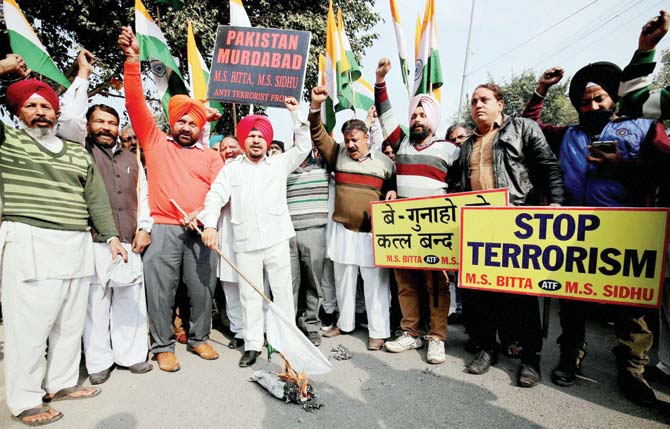There will be more attacks like Pathankot; will the PM remain firm in his pursuit for peace?

 On Saturday night, Home Minister Rajnath Singh told India that the terrorist attack on Pathankot was over and we all went to sleep thanking god it had ended. The next afternoon, upon flying into Delhi, I was momentarily disoriented to find that the terrorist attack was not yet over. More defence and para-military personnel had died. That it still continued was to me more shocking than the fact of the actual attack. It was scary.
On Saturday night, Home Minister Rajnath Singh told India that the terrorist attack on Pathankot was over and we all went to sleep thanking god it had ended. The next afternoon, upon flying into Delhi, I was momentarily disoriented to find that the terrorist attack was not yet over. More defence and para-military personnel had died. That it still continued was to me more shocking than the fact of the actual attack. It was scary.

Members of the Anti Terrorist Front (AIATF) protest in Amritsar on Sunday against the militant attack at Pathankot Air Force base. Pic/PTI
ADVERTISEMENT
Fortunately, Prime Minister Narendra Modi disappeared from Delhi for the weekend, away from the media frenzy. He avoided having to make his natural response — as in September 2014, following a ferocious exchange of fire on the LoC — which would have been of a tit-for-tat tone, because anything less would be a dilution of ‘Brand Modi’. Instead, he issued a banal tweet about the enemies of humanity, and to the delight of detractors, he tweeted the glory of yoga. Considering his macho image, such calm in the face of terrorist provocation would be no less difficult than kurma asana (tortoise pose) or shirsha asana (head stand).
Modi clearly wants to see the peace process with Pakistan through. Otherwise, the attack on Pathankot's airforce base was a good occasion to call it off, if he had even the slightest doubt. And the attack came just under six months after a similar attack on a police station in Gurdaspur: like those terrorists attacked a bus, the Pathankot attackers snatched a policeman’s beacon-lit car; these guys also sneaked in through a nala (drain); they were also heavily-armed, indicating they intended to fight to the finish. And the operation ran on into a second day, despite an intelligence alert that occasioned the deployment of around 50 security personnel in Pathankot; sometimes nothing less than pinpoint intelligence will do.
Modi and National Security Advisor (NSA) Ajit Doval justify India’s current engagement with Pakistan on the ground that we now have a direct line to the military establishment, in the form of their NSA, retired Lt-Gen Naseer Khan Janjua. Then how do we rationalise this attack? The Jaish-e-Mohd is a non-state actor but this operation could not have been pulled off without infrastructural or planning help from the ‘deep state’, the Pakistan army’s Inter-Services Intelligence (ISI) agency. At the very least, it was launched from Pakistani soil.
We’ve long heard about a rogue element — some sort of mysterious and unaccountable ISI officers who are out of control of even the military establishment. That defies the essential nature of any armed force: everyone reports to the army chief. Even the rogue element. Indeed, why is that US President Barack Obama never told the Pakistan Army that he was sending his Navy SEALs to Abbottabad in 2011 to kill Osama bin Laden?
It is said that the 26/11 attack on Mumbai was a plan approved by President Pervez Musharraf before he was deposed — perhaps in frustration that the peace deal he was working with Prime Minister Manmohan Singh had slipped out of his grasp. Our intelligence establishment believes that sophisticated terrorist attacks are part of the Pakistan army mindset — that once in a while, the bloody Indians need a kick in the butt.
It is not surprising, then, that opinion in India is divided on dealing with Pakistan. Some in Modi’s own party say that bilateral relations ought to be frozen for a decade, and then resumed when India can easily dictate terms to Pakistan. Some say we must keep engaging despite the expected “pinpricks” by elements that are hostile to improvement in bilateral relations. Some, oddly, talk about Akhand Bharat. And some say we must retaliate to these “pinpricks”, though such a suggestion is ironic, given that we’ve made a hash of securing one of our most important forward airforce bases.
But if Modi is resoutely pursuing peace — and he should, not because the Americans twist his arm to do so, but because it is the only thing that makes long-term sense — then he has got to know that there are going to be more “pinpricks” in the future. To stay the course will be difficult, and to keep his own establishment in line, he’s going to have to occasionally pull out of his hat another rabbit like the Christmas Day stopover in Lahore.
It is clear that 2016 will be the actual year that defines Modi’s tenure as prime minister. He is taking the biggest gamble of his career; because to stay the course, he has to further invest himself in pursuing peace. That will only get him deeper invested — and the deeper he is invested, the more exposed he is to failure. So he will have to invest more. It’s a difficult asana; let’s wish him luck. Or else for Modi, 2015 will seem like a risk-free cakewalk compared to this year.
Journalist and writer Aditya Sinha is the co-author of Kashmir: The Vajpayee Years. He tweets @autumnshade. Send your feedback to mailbag@mid-day.com
 Subscribe today by clicking the link and stay updated with the latest news!" Click here!
Subscribe today by clicking the link and stay updated with the latest news!" Click here!







